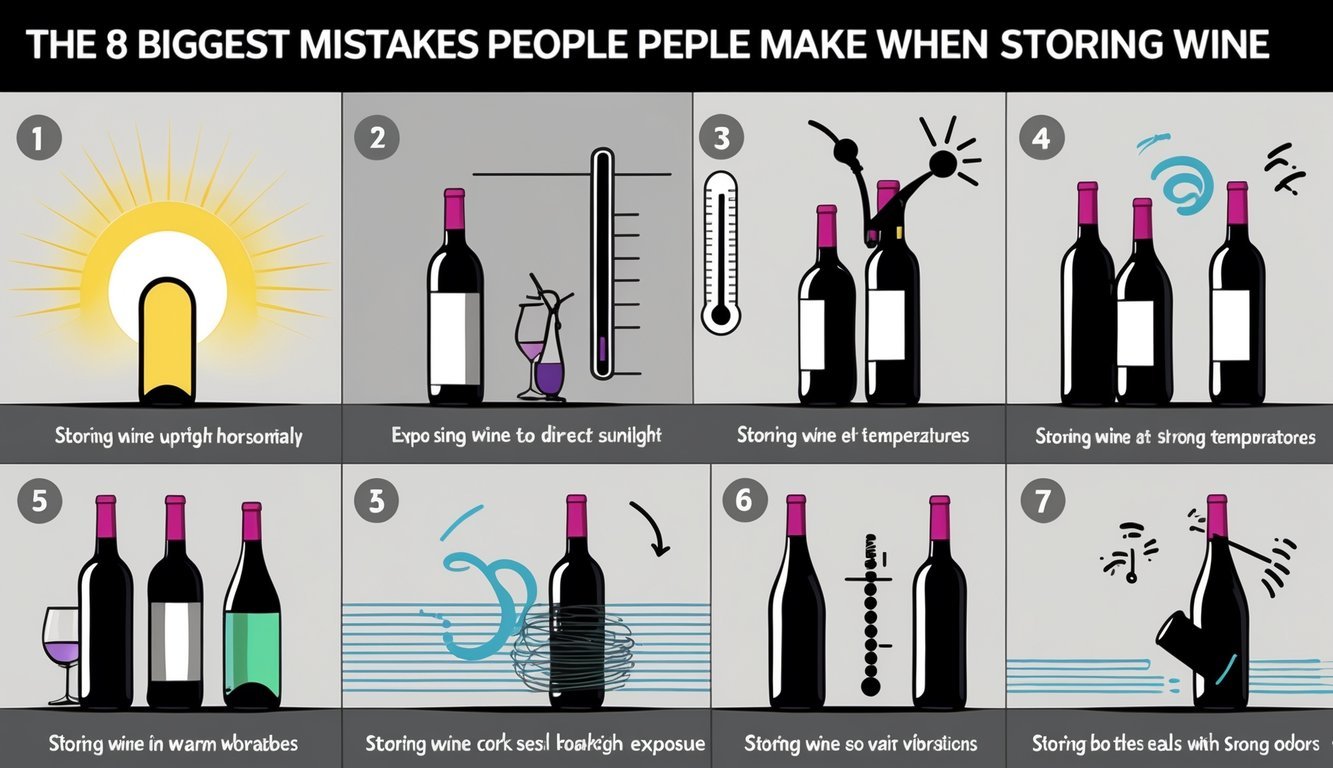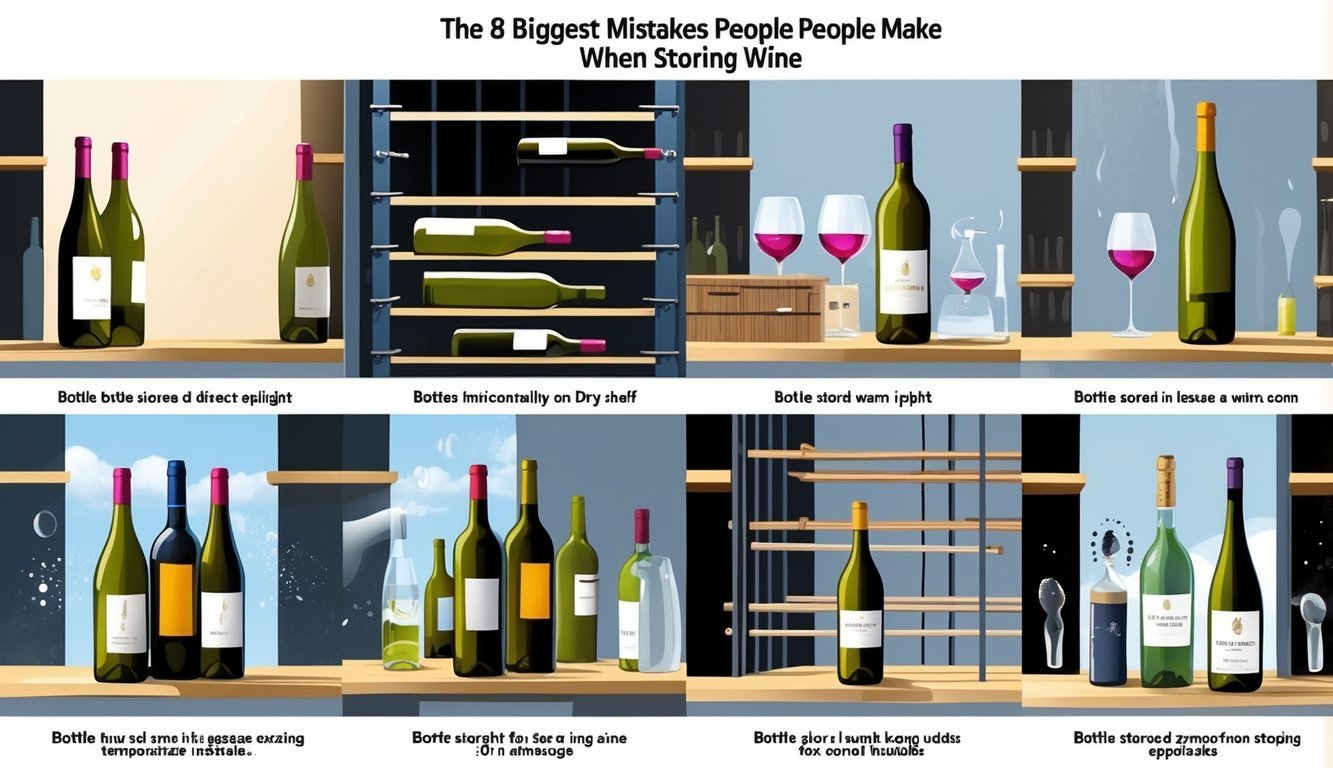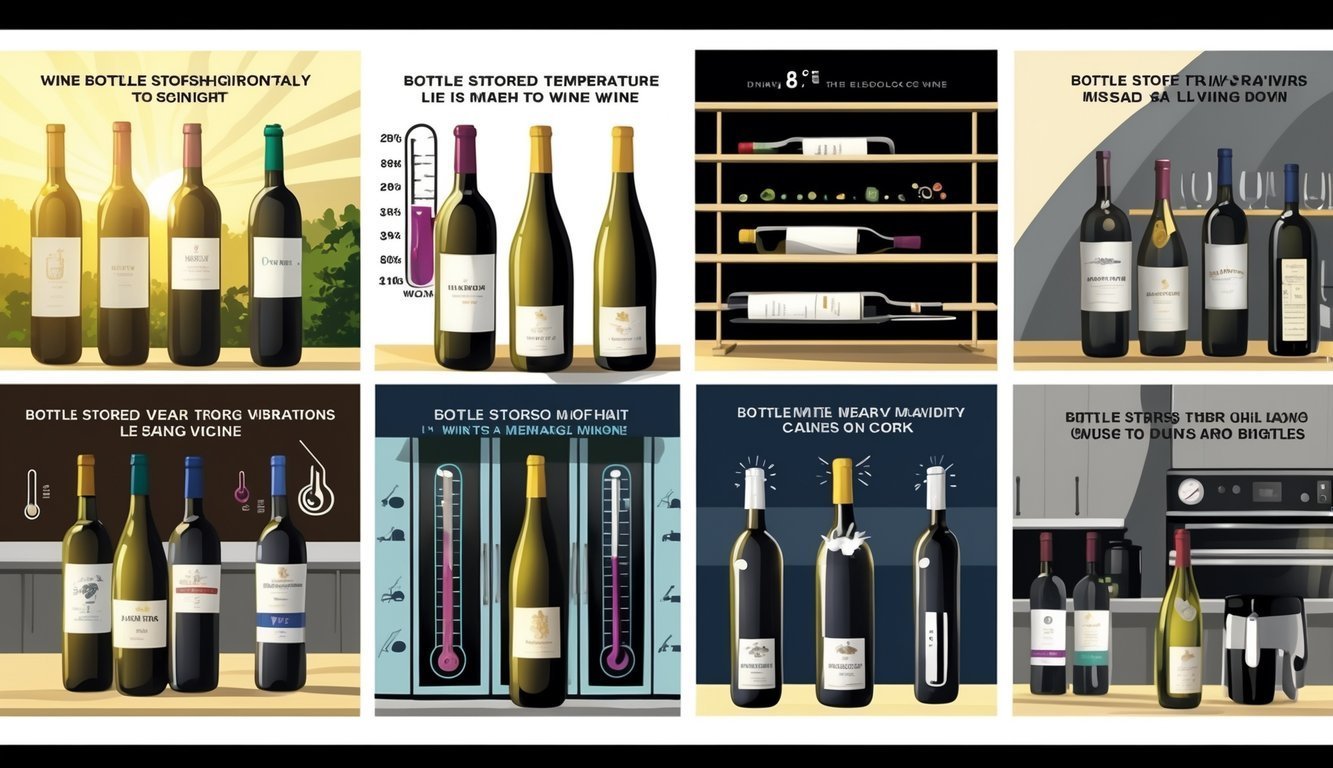PsychNewsDaily Publishers
100 Summit Drive
Burlington, MA, 01803
Telephone: (320) 349-2484
PsychNewsDaily Publishers
100 Summit Drive
Burlington, MA, 01803
Telephone: (320) 349-2484
Storing wine correctly involves maintaining optimal temperature, humidity, and light conditions while ensuring proper bottle orientation to preserve flavor and quality over time.

Storing wine sounds easy, right? But honestly, most people slip up and end up ruining bottles over time. Wrong temperatures, poor bottle placement—just a few of the classic blunders that can mess with the taste and quality.
The main thing to keep in mind: if you control temperature, light, humidity, and bottle position, your wine stays fresh and actually worth drinking.
If you want your wine to age well and taste great, you’ve got to dodge these common storage pitfalls. Maybe you’ve got a few bottles, maybe you’re building a collection—either way, knowing what to avoid helps you get the most from every bottle.
Let’s run through the eight biggest mistakes people make when storing wine, and how you can fix them so your collection actually survives.

How you deal with light, humidity, temperature, and bottle placement totally changes how your wine ages and tastes. Paying attention to these things keeps your reds, whites, or bubbly in the best shape.
If you avoid the usual mistakes, you’ll protect your wine collection and save yourself a lot of disappointment.
Sunlight is bad news for wine. It heats up the bottle and breaks down the good stuff inside. UV rays can cause weird flavors and ruin the taste, especially in lighter wines like Sauvignon Blanc or champagne.
Sunlight also speeds up aging in all the wrong ways. Keep your wine somewhere dark—think wine cellar, cool cabinet, or just away from windows and harsh lights. If you don’t have a cellar, use UV-protected racks or slip on those tinted covers.
Sunlight can also fade or peel labels, and the heat dries out corks. Once that cork dries, air sneaks in and the wine’s toast.
Humidity matters more than most folks realize. If the air’s too dry, corks shrink and let air in, which means oxidation and ruined flavor. Too much humidity? Now you’ve got moldy labels and corks, and bottles that look (and smell) gross.
Shoot for 60% to 70% humidity. That’s the sweet spot—corks stay moist, mold stays away. A cheap hygrometer tells you what’s going on, and a small humidifier or even a tray of water can help.
Sparkling wines and champagnes need stable humidity too. Otherwise, you risk pressure loss or a dried-out cork.
Getting the temperature right is tricky. If it’s too warm, wine ages too fast. Too cold, and flavors get muted—or worse, the wine freezes and the bottle cracks.
Stick to 50°F to 59°F (10°C to 15°C). Red wines like it a bit warmer, while whites and bubbly prefer things cooler. Avoid kitchens, garages, or anywhere with wild temperature swings.
When temperatures bounce around, the wine expands and contracts. That can actually push the cork out, letting oxygen in and spoiling the wine.
The way you stack bottles isn’t just about saving space. If you store bottles upright for too long, corks dry out and air gets in. That’s especially rough on reds that need time to age.
Lay bottles on their side in a rack. This keeps corks moist and saves space. But don’t just pile bottles on top of each other without support.
If you do, labels get scratched, bottles roll or fall, and your collection’s at risk. Try to group wines by type or age, and don’t mix reds, whites, and bubbly in wobbly stacks.

Little details can make a big difference in how your wine ages and tastes. Pay attention to where and how you keep your bottles, and what you’re storing together.
Vibrations mess with wine. If your rack sits near a washing machine, fridge, or big speakers, the wine gets shaken up too often. That stirs up sediment and makes the wine cloudy and less fun to drink.
Find a spot where bottles won’t get bumped or rattled. A sturdy rack on a solid surface does the trick. People who love wine swear that less vibration keeps flavors cleaner and the texture smoother, especially for reds like Cabernet or aged whites.
A lot of people set bottles upright, but that dries out the cork. Once the cork dries, air sneaks in and spoils the wine. This is risky if you’re storing bottles for months or years.
If you plan to keep wine for a while, lay bottles on their side. That keeps the cork moist and sealed. Use a rack that holds bottles horizontally. This goes for sparkling wine and champagne too.
Reds, whites, and sparkling wines each want different storage conditions. Reds can handle it a bit warmer. Sparkling wines need cooler temps and tighter humidity.
If you lump them all together, you get temperature swings or the wrong humidity. That messes with flavor and shelf life. Whites like Sauvignon Blanc stay fresher cold, reds do better a bit warmer.
A lot of wine lovers use separate areas or fridges for each type.
Older wine gets sediment at the bottom. It’s normal, but if you pour it into your glass, it tastes bitter and gritty.
To handle this, store bottles slightly tilted so sediment collects near the cork. When you pour, go slow. Use a decanter or filter to keep sediment out of your glass. This is especially important for aged reds.

Temperature, bottle position, and how long you store wine all matter if you want to keep your wine at its best. Watch for signs your wine wasn’t stored right, so you don’t get a nasty surprise.
Keep wine around 50°F (10°C). Too hot or too cold, and it’ll spoil.
Sure, storing unopened white wine in the fridge for a little while works. For longer storage, aim for a cooler, steady spot.
It really depends. Most wines are best within 1 to 3 years, but some reds and fancy bottles last 5 to 10 years or more—if you store them right.
Absolutely. Store bottles on their side to keep the cork moist and airtight. That keeps air out and the wine tasting good.
Look for a swollen cork, strong vinegar smell, or weird colors. Those usually mean the wine’s been stored badly.
Absolutely, temperature swings and too much light can really mess up wine. If you want your wine to taste good for longer, stash it somewhere cool, dark, and steady.
Honestly, it’s worth the effort.